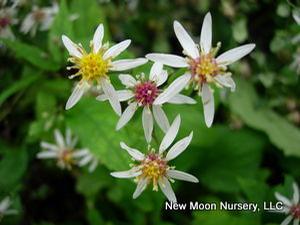New Moon Nurseries
Aster divaricatus
White wood aster
Native to North America
FIRST IMPRESSIONS: Aster divaricatus is a low mounding perennial with heart shaped or oval leaves. In late summer starry white daisies cover the plant and gleam in the shade. Plants are tough and adaptable prospering in part shade or shade and in dry or moist soils.
HABITAT & HARDINESS: The range of Aster divaricatus extends from southeastern Canada south through most of the eastern United States.
This is a woodland aster that occurs in dry open woods, in clearings, on roadsides and on the edges of deciduous forests.
Plants are hardy from USDA Zones 3-8.
PLANT DESCRIPTION: Aster divaricatus is a mounding perennial that forms dense colonies from underground rhizomes.
Heart shaped leaves occur at ground level and smaller ovate leaves higher on the stems.
Flat topped branched flower clusters appear from late summer until mid-fall. The fragrant flower heads are composed of a ring of white petal-like ray flowers surrounding a central cluster of yellow or rose colored disc flowers. Flower heads are produced in profusion and are frequented by bees and butterflies.
Plants grow 2-3’ tall with 2-4’ spread.
CULTURAL & MAINTENANCE NEEDS: The great advantage that Aster divaricatus offers is the ability to grow and flower in dry shade. Flowering and form are best, however, in partly shaded sites where plants have 3 hours or so of sun.
Plants tolerate average, dry or moist soil. They self-seed to the point that some describe the plant as “weedy”. This should not be an issue in a natural setting but in smaller gardens, dead-heading can limit seed production.
Aster divaricatus is drought tolerant and somewhat unpalatable to deer and rabbits.
To encourage density, plants can be cut back to 6” in late spring.
LANDSCAPE USES: This is a good choice for a Wildlife Garden or Shade Garden. Plants are also used as Butterfly Nectar Plants, Butterfly Host Plants or as part of a Grouping or Mass Planting. Aster divaricatus has Showy Fragrant Blooms and can be used in Cottage Gardens, Deer Resistant Plantings, Water-wise Landscapes, Low Maintenance Plantings, Dry Meadows, Perennial Borders, Roadsides and Restoration Projects.
COMPANION & UNDERSTUDY PLANTS: At woods edge try pairing Aster divaricatus with Eupatorium colestinum, Heliopsis helianthoides, Solidago caesia, Aquilegia canadensis and Amsonia hubrichtii.
Aster cordifolius has similar height and habitat needs and can be substituted if needed.
TRIVIA: Many of the established Latin names of Aster spp. were changed recently due to DNA and genetic research findings. So Aster divaricatus is now known as Eurybia divaricata.
This species is very similar to Aster cordifolius. Differences in the two include the fact that Aster divaricatus blooms a little earlier, is shorter and not as upright. Aster divaricatus has white ray flowers that are larger but usually produced in smaller quantities.
Plants host caterpillars of the Pearl Crescent and Checkerspot Butterflies.
The Chicago Botanic Garden’s Plant Evaluation Program conducted a comparative study of 119 different asters. Aster divaricatus was one of 7 asters that received the highest rating. According to the study, “Top rated asters displayed consistently strong habits, superior flower production, excellent disease resistance and full winter hardiness throughout a six-year evaluation term.”
Height:
2-3 FeetSpread:
3-4 ftSpacing:
2-3 ftUSDA Hardiness Zone:
3-8Bloom Color:
WhiteAster divaricatus Characteristics
Attracts Wildlife
- Butterflies
Attributes
- Drought Tolerant
Exposure
- Partial Shade to Full Shade
Flowering Months
- November
- October
- September
Foliage Color
- Green
Juglans nigra Tolerance (Black Walnut)
- Yes
Soil Moisture Preference
- Moist to Dry
Interesting Notes:
AKA Eurybia divaricata
For more information on this plant, visit the USDA PLANTS Database: http://plants.usda.gov/java/profile?symbol=EUDI16
